The appearance on the market of solid fuel boilers with automatic feeding has greatly simplified the lives of many consumers for whom gas or electric heating is not available. The development of production has led to the creation of many models for various purposes. Knowledge about the structure, operating principles and types of automatic units will help you choose the most suitable and profitable option.
Features of boilers with automatic feed
The elements of the boiler installation, which are directly responsible for burning fuel and transferring heat to the home heating system, do not differ significantly from conventional solid fuel devices.
The main operational advantage of devices with automatic feeding is ensured by the presence of three basic components in their design:
- fuel bunker for one-time loading of large volumes of flammable materials;
- screw conveyor for regular transfer of fuel to the combustion chamber;
- complex automation responsible for the operation of the entire system.
The listed design elements provide the possibility of long-term combustion without additional maintenance of the boiler installation. To operate such equipment, human intervention is required no more than once every 1–2 weeks, and sometimes less often.
The automation also regulates the amount of fuel supplied, which depends on the current coolant temperature and the one set in the settings. When the bin is almost empty, the system notifies you to fill it.
Many models also feature the ability to automatically remove combustion products. That is, the entire process from ignition to cleaning in such units is carried out without human intervention.
Long-burning solid fuel boiler - varieties.
The honorary title of a long-burning solid fuel boiler is given to any device that maintains combustion throughout the day. If a boiler burns out for a day, it gets the long-burning status, if two boilers burn out, the status doesn’t change, if it burns out for a week, they all get the same name.
Thus, we can find a device with a different period of fuel smoldering support, while the very phrase “long-burning solid fuel boiler” is unlikely to reveal to us all the technical characteristics of the device.
Only two main types of equipment are distinguished in this segment - a long-burning wood boiler and a long-burning coal boiler. Both devices are capable of servicing both a water circuit system and a glycol-based coolant system. In addition, a long-burning solid fuel boiler has a number of distinctive features, which we will focus on.
Types of boilers by type of fuel bunker
There are two types of loading devices: built-in fuel hopper and mechanized storage. The battery life and the area occupied by the boiler installation depend on which of them the unit is equipped with.
Built-in fuel hopper
Models with a built-in loading device are equipped with a container for solid fuel, which is located on top or on the side of the main chamber of the boiler. The advantage of this design is the relative compactness of the heating installation. However, in terms of battery life, models with a built-in bunker are inferior to units with mechanized fuel storage.
Mechanized fuel storage
Here, a separate room or part of a room with a connected flammable material supply system acts as a loading device. The volume of such storage is enough to accommodate a year's supply of fuel.
The models are distinguished by a complex electronic automatic control system, which fully regulates all work processes, as well as the presence of a remote control unit.
Design and principle of operation of a mine boiler
In practice, domestic mine TT boilers using bottom-burning wood work as follows:
Firewood is placed in a vertical combustion chamber and ignited through a special hole at the bottom of the boiler.
There are varieties of mine boilers, usually called by the names of their creators (Kholmov, Efimov, etc.). A design feature of each model is a spacious combustion chamber with vertical stacking of firewood.
Automatic fuel supply methods
Based on the methods of fuel supply, units with a pneumatic conveyor and a screw transmission are distinguished.
The choice of design depends on:
- noise level during operation of the heating installation;
- power consumption;
- frequency of fuel delivery to the combustion chamber and other indicators.
Pneumatic conveyor
Combustible materials are delivered to the main chamber of the boiler using air, which is pumped under pressure. The advantage of such models is that fuel is supplied less frequently. As a result, the system will be able to operate without electricity for a longer time. However, the pneumatic conveyor makes more noise during operation and consumes a lot of electricity - about 1.5–2 kW/hour.
Screw transmission
This method is used in most household units and is considered the most reliable, but it is not ideal.
Feeding is carried out via a screw conveyor, which operates almost silently and consumes less electricity - about 80 W/hour. The feed speed is adjusted automatically.
The use of an auger guarantees the flow of fuel into the boiler, but if its length is more than 2 m, flammable materials are ground into dust.
Application and effectiveness
Coal boilers for heating a private home have found application in regions of Russia where there is no main gas supply, and there is also a shortage of other energy resources: firewood, electricity.
The popularity of coal is higher near major transport hubs, since large quantities of coal are mainly transported by rail.
In order to increase the efficiency of a coal boiler, it is necessary to perform a number of measures. They start by choosing a brand of coal. It is mined in mines and may contain 15-20% waste rock, which cannot burn and produces a lot of ash.
Unprocessed coal has an ash content of up to 30%. Therefore, for energy purposes, coal undergoes special processing at enrichment complexes, which increases the efficiency of units, for traditional coal devices up to 70-75%, and for automatic ones - almost up to 90%.
In addition, in order to increase the economical operation of the heating system of a house equipped with a coal-fired unit, it is necessary to take into account the following points:
- Do not use raw coal, since a significant part of the energy from the thermal cycle will be used to dry it.
- Monitor the condition of the chimney system and heating surfaces of the boiler; they must be clean.
- Provide sufficient air. In the room where the unit is installed, there must be effective triple supply and exhaust ventilation.
- Use thermostats in the operating circuit of an automatic coal boiler.
- Effectively insulate your home.
- Improve the in-house thermal circuit, install a circulation pump and an indirect hot water heating boiler.
Pellet automatic units
One of the most common types of heat generators is systems powered by wood pellets. The operating principle of pellet boilers is in many ways similar to other automatic units, but there are also characteristic features.
If you trace the similarities and differences, as well as the advantages and disadvantages of such models, it will be easier to choose the appropriate option.
Principle of operation
The basic design of pellet systems is no different from other common automatic heat generators. Combustible materials are loaded into the fuel bunker, from where they are gradually poured onto the screw conveyor. The shaft transfers the granules to the combustion chamber, where the coolants are heated.
Differences in operation can be seen at the fuel supply stage:
- After starting the auger, the mechanism directs the pellets first into a flexible hose or plastic tube, which dumps the pellets into a dispenser.
- In the metering device, the second shaft measures the required portions of fuel and moves them to the reed valve.
- The gate opens and the pellets are dumped onto a third auger, which transfers a measured amount into the firebox.
The described algorithm may vary slightly depending on the implementation of a particular model.
Advantages
The economic and operational benefits of pellet heating systems are mainly related to the merits of the type of fuel used.
Wood pellets are not inferior to traditional combustible materials in terms of calorific characteristics, but have a number of advantages:
- lower cost;
- economical consumption, which leads to longer operating time without additional loading;
- increased environmental friendliness;
- minimum amount of combustion products in the ash pan.
As for the advantages of the boilers themselves, as a rule, they are smaller in size compared to units operating on other types of fuel.
Flaws
In addition to the listed advantages, there are also disadvantages.
Since the flame in most pellet models has a horizontal direction, overheating of the boiler structural elements may occur. In addition, the efficiency and power of such equipment is lower.
Operation: how to properly heat a boiler with coal
Ignition of coal boilers is carried out with a small amount of wood chips and paper, after which the firebox door is closed. Open the blower so that the draft ensures the combustion process. If the unit has an air supply regulator, it is set to a temperature of 70 C.
After burning wood for 20 minutes, the boiler firebox and gas ducts warm up enough that coal can be thrown in. The gate valve opens completely. During the lining process, the blower is closed. Only after this do they open the combustion door and lay a layer of coal up to 6 cm, and after it has burned out, the next layer of coal will need 20 cm.
Summarizing the above, we can draw the following conclusion that solid fuel boilers operating on coal fuel are still in demand, both in the field of individual heating of residential buildings and in production, where industrial coal boilers are still functioning in sufficient quantities.
Modern advances in the field of boiler construction make it possible to use cast iron heating surfaces in the most advanced innovative boilers.
Automatic boilers running on wood chips and coal
This option of automatic units should be preferred by residents of regions where the cost of coal is comparable to the price of pellets. Otherwise, their operation will cost more.
The main advantage is higher efficiency rates. However, coal emits a significant amount of soot and tar, which leads to less environmental friendliness. Equipment maintenance is carried out more often, as more ash is released during combustion.
For coal boilers, there is a requirement for the size of combustible material granules: from 4 to 25 mm in diameter. This is necessary for the smooth operation of the screw conveyor.
How to choose
When choosing a specific model of coal boiler for a residential building, several factors should be taken into account: thermal power and size of the heated area, type of combustion, type of heat exchanger - cast iron or steel, energy independence, safety, efficiency, weight of the unit and its price.
Direct long burning or pyrolysis
In order to compare boiler units by type of combustion: long burning or pyrolysis, compare the main operating parameters of coal boilers:
- Efficiency: Long-term combustion - from 75 to 85%, pyrolysis - from 85 to 92%.
- Possibility of autonomous operation: long burning - yes, pyrolysis - yes.
- Energy independence: long burning - yes, pyrolysis - yes.
- Permissible fuel humidity: long burning - from 30%, pyrolysis - up to 15%.
- Acceptable fraction: long burning - up to 50 mm, pyrolysis - from 25 mm.
Thus, today it is possible to draw the main conclusion - it is simply not possible to burn fuel more efficiently than in an automatic pyrolysis solid fuel boiler using coal and wood.
Heat exchanger material
The type of material from which the body of a coal boiler is made is the main factor that determines the durability and maintainability of the heating system:
- Steel is a relatively light metal that can withstand changes in pressure and temperature. Its disadvantages include susceptibility to corrosion processes and burnout in the zone of maximum temperatures.
- Cast iron is the most durable material and is used in all powerful units. However, it does not withstand shock and temperature changes well. In addition, if fistulas form in the walls, it will not be possible to weld them, as in steel products.
Modern boilers, using the positive qualities of both metals, are produced in a steel body and with a cast iron combustion chamber.
Single-circuit or double-circuit
Single-circuit or double-circuit are available, either only for heating, as in the first option, or, respectively, for heating and hot water supply - in the second.
In this case, double-circuit boilers operate on the principle of switching hot flue gases to the DHW circuit when the valve on the mixer is opened. Coal units have a fairly pronounced low inertia, so it is practically possible to regulate the heating medium between the circuits only in pyrolysis devices.
Therefore, for many options for coal boilers, the preferred hot water supply scheme remains, organized through an additionally installed indirect heating boiler. In this case, the efficiency of the heat supply system is significantly increased by reducing the temperature of the exhaust gas.
Minimum required power and heated area
In order to determine the approximate thermal power, use a practical formula depending on the heated area of the room:
Mk = Pd x 0.1 where:
- Mk - design power of the boiler, kW;
- Pd - area of the house, m2.
- 0.1 - specific power indicator per 1 m2 of area (W/m2).
This calculation does not take into account many more important parameters of the house, for example, such as the level of thermal insulation, glazing area, roof structure and climatic region of residence.
These calculations are complex and can only be performed by special design organizations or using software packages.
Therefore, in everyday life, an approximate calculation is carried out, which is carried out according to the principle “from small to large” - the power is set for each room separately, and then the result is summed up. This approach also allows you to determine the number of metering devices required for each room.
Another difference for coal boilers in this calculation method, which will need to be taken into account when selecting equipment. The power according to the formula takes into account the calorific value of standard coal, which in reality is much worse, so an adjustment of 20% is made to accurately determine the coal consumption in a solid fuel boiler.
Efficiency
Efficiency - represents the ratio of the volume of fuel consumed to the volume of thermal energy generated by a coal boiler. This is the most important indicator of equipment efficiency and fuel use.
It depends on the thermal design and the use of innovative technologies in the boiler design. In EU countries, due to strict environmental protection requirements, the installation of new devices with an efficiency below 90% is not allowed. High-tech condensing domestic boilers today operate with an efficiency of 100-105%.
Recommendations for selection
Choosing the most suitable model depends on many factors. First of all, you need to decide on the type of fuel, prices for which may vary depending on the region.
After this, it is worth calculating the area that is available for installing the boiler system, and taking into account the wishes for battery life. This will help you determine the most appropriate dimensions of the boiler and the capacity of the fuel bunker, which will significantly narrow your search.
To take full advantage of the potential economic and operational benefits of automatic boilers, you need to pay attention to the following parameters when choosing:
- boiler power (must correspond to the area of the heated room);
- availability of economical modes;
- demands on the quality of fuel, its ash content;
- reliability and safety of long-term battery life;
- reproduced noise in various modes;
- availability of automatic ignition and ash collection functions;
- electricity consumed;
- possibility of operation from rechargeable batteries;
- the size of the ash bin and the ease of cleaning it;
- efficiency of working with different types of fuel pellets and in different modes;
- the presence of a remote control or the ability to additionally connect it.
You also need to pay attention to the appearance of the boiler, including the quality of the welds.
Long-burning solid fuel boiler Stropuva
Since we are talking about companies that produce long-burning solid fuel boilers on the market, we cannot ignore the well-deserved leader - the Stropuva company. A Lithuanian boiler is capable of operating on one filling of coal for up to 120 hours, on pellets 72 hours, on wood 30 hours respectively.
Very good parameters for this type of long-burning boilers. Let’s also look at why Stropuva boilers have gained such great popularity:
- Long burning. Reaches 5 days.
- Multi-level security. The company claims that during overheating and overload, the boiler device contracts like a tin can under foot load and under no circumstances does it explode, but only shrinks inward.
- Economical. Optimal characteristics of resource use. Wood waste can be used as fuel.
- Energy independence. The Stropuva boiler does not require electricity.
- Ecology comes first and meets high European standards.
- Attractive appearance.
- 5 year warranty.
It was not for nothing that Lithuanian engineers designed a long-burning boiler in the shape of a cylinder. Now, thanks to its compact size, installation of the Stropuva boiler does not require a large area and can fit in the limited space of a city apartment.
Review of the best manufacturers and prices
There are many models of heating units available to the modern consumer. Making a choice in such a situation is quite difficult. Understanding popular models and manufacturers will help simplify the situation.
Germany
German-made boiler equipment is the standard of quality. The models have a high level of efficiency and operate without failures. It is not surprising that systems manufactured in Germany have the highest cost, about 450–600 thousand rubles.
First of all, it makes sense to pay attention to the heating systems Buderos, Heiztechnik and ThermoFLUX.
Prices for solid fuel boilers Buderos
solid fuel boilers Buderos
Italy
Among the Italian-made models there are many universal options. For example, Lamborghini Ecologik series boilers can operate on wood, coal, peat and briquettes. And after installing additional equipment (adapter door, pellet burner, auger and hopper), pellets will also be suitable as fuel.
Italian models have an average price category. Brands that have proven themselves in the market: Lamborghini, D'Alessandro Termomeccanica, Faci.
Prices for solid fuel boilers Lamborghini
Lamborghini solid fuel boilers
Türkiye
Turkish boiler systems belong to the middle price segment. They have a good quality automatic feeding system and are equipped with a convenient control panel. One of the most popular manufacturers is Totem, which produces silent boilers with easy temperature control. The brands Emtas and Termodinamik are also known.
Russia
Russian automatic boilers are in constant demand on the domestic market. Manufacturers have achieved significant success through the introduction of modern design methods, new manufacturing technologies and continuous improvement of designs.
The models have an attractive appearance, high-quality assembly, good automation and benefit in terms of price. Their cost starts from 80–100 thousand rubles, which is relatively inexpensive compared to imported analogues. The most famous brands: Danko, Pereko, Obshchemmash Peresvet, Obshchemmash Valdai, NMK Magnum.
Japan
Japanese products are characterized by a high degree of automation. Many additional built-in functions significantly increase ease of use. The models are also distinguished by an ergonomic shape and high-quality materials for manufacturing, usually steel with anti-corrosion treatment.
Prices for automatic solid fuel boilers made in Japan are not inferior to the cost of models from Germany. The most popular manufacturers: Kentatsu, Rinnai.
Prices for solid fuel boilers Kentatsu
solid fuel boilers Kentatsu
Serbia
The Serbian manufacturer Radijator produces universal, highly environmentally friendly units that are equipped with an overheating protection system and are resistant to ash deposits. Allows to obtain an efficiency of about 90%. Pass mandatory quality checks.
China
Most Chinese products are not of high quality and reliability. The exception is units of the Chinese brand Roda (the manufacturing country is usually Türkiye). The design of the models makes it easy to clean the flame tubes, which maintains high combustion efficiency. The average cost of such equipment is 150 thousand rubles. Check out the link for the best heating batteries for an apartment.
Long-burning solid fuel boiler - pros and cons
In the absence of a gas main, there are not many alternatives to build a heating system. You can install a gas tank, provided that gas supplies are established in the region. You can use environmentally friendly, but expensive electricity by connecting an electric boiler. But what to do if such options are not affordable? Or are gas and electricity resources limited or non-existent?
A long-burning solid fuel boiler will not require significant installation costs from the owner and will provide a reasonable replacement for the listed heating methods.
Advantages:
- Easy to use. Traditional work with wood, pellets or coal does not require special skills. Cleaning up ash takes no more than an hour a week.
- Durability. Service life exceeds 10 years. A long-burning boiler is an unpretentious technique. A simple design, with careful operation, can serve for several decades.
- Ecologically pure . The afterburner ensures almost complete combustion of the fuel. Emissions of harmful substances are a natural product of combustion - processed as a result of photosynthesis.
- High efficiency . There are models on the market with a value of up to 90 – 95%. Minimum heat losses are ensured. Engineering solutions optimize the process of afterburning pyrolysis gases. The heat exchanger design is designed with maximum heat transfer to the coolant.
- Efficiency and economy . Modern equipment is not much inferior to gas analogues. The effectiveness of long-term burning reaches seven or more days.
- Reasonable fuel cost. Sometimes it’s the only possible one. Frees you from dependence on expensive gas equipment.
- There is no permitting documentation for installing the boiler. There is no requirement to conclude service agreements with gas services.
- A long-burning solid fuel boiler allows you to provide home ownership with hot water, if there is a second circuit. In addition, an indirect heating boiler will help expand functionality.
Flaws:
- Constant involvement of the owner . Despite the long combustion process from one load, sooner or later you have to return to replenishing the loading compartment with fuel.
- Regular cleaning . Probably the least popular maintenance process, it requires constant cleaning of ash. All that remains is to envy the clean gas equipment or electrical appliances.
- Separate room . You will have to allocate a separate room with good ventilation and a chimney. A long-burning solid fuel boiler for a private home usually has significant dimensions; it may be necessary to prepare a special installation site with a reinforced foundation.
- Maintenance of fuel stocks . Replenishment and preservation of fuel residues will require additional financial investments. Compliance with safety measures and maintaining a certain moisture content of the product also adds problems in resolving storage issues.











